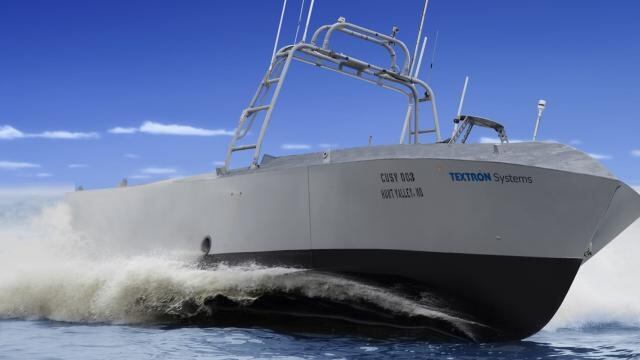WASHINGTON — The U.S. Marine Corps is looking for long-range unmanned surface vessels to resupply Marines on islands scattered around the Pacific, and Textron Systems thinks it has a solution.
The Navy has been developing the Common Unmanned Surface Vehicle as part of its mine countermeasures program for littoral combat ships, but Textron is eyeing another program coming around the bend: The Marine Corps’ long-range unmanned surface vessel program, or LRUSV.
The LRUSV was mentioned in Marine Corps Commandant Gen. David Berger’s recent planning guidance as a particularly useful asset in war games, and defense industry watchers anticipate a request for proposals in the near future.
Textron thinks the Common Unmanned Surface Vehicle could be the solution. CUSV, which Wayne Prender said is heading for a low-rate initial production this year, is well-suited to attach to vessels of opportunity and bring any number of payloads to Marines in theater, said the senior vice president of applied technologies and advanced programs at Textron.
“CUSV is payload agnostic, and it has sizable payload [space, weight, power and cooling],” Prender said. “We have the endurance in terms of data link and fuel to navigate and travel. By nature, the mine countermeasures platform is designed to operate in the littorals, in shallow water, [making] it a natural fit.”
RELATED

The Marine Corps previously considered arming the LRUSV with weapons and using it as logistics drone, both functions that CUSV could handle, Prender said.
“It could come off a vessel of opportunity, or an [amphibious warship with] a well deck, or an LCS with whatever package you would need: whether that’s a mine-hunting, sweeping and neutralization payload, or a direct or indirect fire weapon, or beans, bullets and Band-Aids — delivering that to another ship or beachhead.”
Marine Corps Lt. Gen. Eric Smith, who heads the service’s combat development and integration office, said last fall during a roundtable with reporters that the goal was to field as many drones as possible with a mix of payloads that would, like the Navy’s Distributed Maritime Operations concept, confuse the adversary, who wouldn’t know if the drone is carrying medical supplies or a lethal payload.
“I don’t want to be efficient, I want to be effective,” Smith said. “If the vessel is cheap enough that I can send three out but only need one to get there, well that’s terribly inefficient but super effective.
“And if we’re going to do cost imposition and you are the adversary, I guess you are going to need to target all three.”
David B. Larter was the naval warfare reporter for Defense News.








